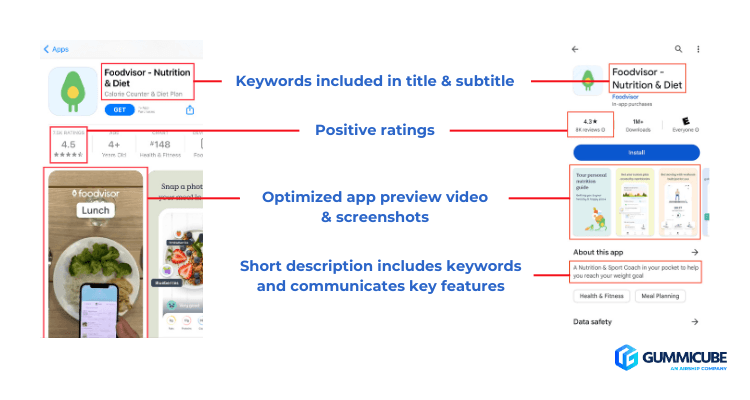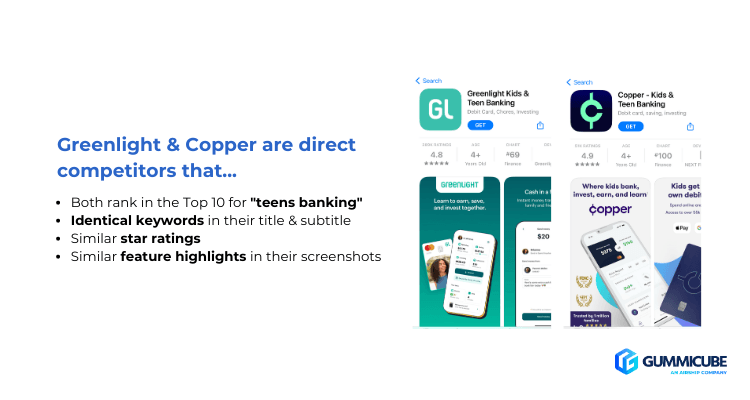App Store Optimization (ASO) is a vital component of any successful mobile app marketing strategy. It involves optimizing various elements of your app listing to increase visibility, attract organic traffic, and ultimately drive more downloads. In this comprehensive guide, we will walk you through the key steps of developing an effective ASO strategy so you can take your app to new heights.
Performing an app baseline analysis
Before diving into ASO tactics, it’s essential to understand your app’s current performance and identify areas for improvement. Carrying out a baseline analysis will help pinpoint exactly what needs work so you can effectively optimize. Ask yourself the following questions when studying your current app listing.
App store listing analysis
- Keywords: Are your keywords relevant to your audience and current market trends? Have you identified the terms that have seen their rank increase and the ones that are potentially holding your app back?
- App metadata: Does your app metadata effectively showcase what your app does and why users should download it? Are you balancing the use of relevant keywords and engaging copy to express your service’s value proposition?
- Creatives: Are your creatives visually appealing and conveying the essence of your app? Do your app icons, screenshots, preview videos, and feature graphics do an effective job of capturing user attention?
- Ratings and reviews: Are your reviews contributing to app growth or driving away users? Are you regularly addressing both positive and negative feedback your app receives?
Foodvisor breakdown
Source: Gummicube
Foodvisor is a good example of an app whose App Store and Play Store pages take into consideration the two platforms’ different layouts and optimizes for each one.
Performance metrics analysis
Studying your performance metrics can also help you understand which app listing elements need optimizing. As each asset contributes to app growth differently, the distinct KPIs derived from your baseline performance analysis should drive your strategy toward improving your listing.
- Keyword rankings: Your current keyword rankings provide valuable insight as to which terms and phrases are contributing to app store growth and which ones aren’t. By identifying the terms your app is performing well for, you can prioritize them and related keywords further and phase out ones that can be replaced by others with a higher potential for growth.
- Downloads and installs: Evaluate the number of downloads and installs your app has received over time. By spotting any spikes or drops, you can correlate them with specific market trends, previous metadata and creative updates, and changes in user behavior attributed to certain periods of time.
- Crash reports: Review crash reports to identify and fix any technical issues that may impact user experience and app stability. Apps suffering consistent crashes will be penalized by platforms, with Google even notifying users of poor performance through warning labels in the Play Store listing.
- Reviews and ratings: Your reviews and ratings are a direct reflection of your in-app experience and can have a strong impact on your downloads. It’s essential to keep a high app rating and address the flaws of your app to avoid them negatively affecting your app rank. Users may not even consider clicking on your app in search results if they see a rating under 4 stars.
App store competitive analysis
Understanding your competition is crucial for developing a successful ASO strategy. A thorough mobile app competitive analysis can provide insight into what currently works in your market so that you can emulate winning strategies and fill in gaps where detected.
Identify competitors
Start by researching your app category for competitors offering similar services or features. Once you have identified them, narrow down your selection to those that are most likely targeting the same niche you are. This is an important step as you may have an app that has a similar product offering but is aimed at different demographics.
For example, your app’s main focus may be online banking for teens looking to start their financial journey, while another app’s is online banking for high net-worth individuals with extensive portfolios. The needs and expectations of each group will likely vary greatly.
Once you have chosen the competitors most related to your app, you can begin to analyze app marketing strategies they are implementing that can also work for you.
Analyze competitors’ app store strategy
Your top competitors house valuable information for your own ASO plan. Their app listings provide the insight you need to understand what strategies work and which ones you can improve upon. You can then implement each of these for your own app, adapting them to fit your metadata, creatives, and overall app marketing objectives.
Keywords not only indicate what terms a competitor is prioritizing but can also act as a glimpse into what your target audience is searching for. If a top-ranking competitor is actively using a specific term as part of their keyword strategy, there’s a good chance that word or phrase is contributing to their app’s visibility. This idea can be reinforced further if multiple competitors are targeting the same keyword with similar placement in their metadata.
Creative assets can also provide insight into what video and screenshot best practices are popular among high-performing competitors. When it comes to developing app preview videos and images, there can be commonalities between apps that contribute to higher engagement, clickthrough rates, and conversions. Some design strategies include using phone models in screenshots, emphasizing UI elements, or illustrating popular characters associated with the company’s brand.
Your competitors’ tone of voice can also potentially provide insight as to what language your target audience is more receptive to. Perhaps certain words resonate with users more, or maybe the way features are structured within descriptions helps communicate an app’s value more. By analyzing how other apps in your market write their copy you can develop your own messaging that connects with potential users.
Lastly, competitor ratings and reviews are an effective source of user feedback. Studying what users are saying about a certain app can help you understand how your value proposition can capitalize on the pains and needs of potential users.
Greenlight and Copper
Source: Gummicube
Greenlight and Copper are two high-ranking banking apps aimed at kids and teens that clearly employ a similar strategy when it comes to keyword targeting and creative optimization. Each app takes inspiration from its competitor(s) to maintain its current position for terms contributing to growth.
App listing iterations
ASO is an iterative process that requires ongoing optimization to stay competitive. Regular updates to your app listing can help maintain your app’s relevance and ranking through strategic metadata and creative refreshes. These iterations should become a consistent part of your ASO plan and should take into account user behavior, shifting market trends, ranking fluctuations, and more.
Metadata and creative updates
When it comes to keeping your app listing information up to date, regular edits to your app copy and visual assets can have a strong cumulative effect on your rankings over time. Your first optimization lays the groundwork for the keywords you’d like to target, but it’s the continuous analysis and modification of assets that will help you progressively grow. This doesn’t mean your app listing needs to undergo a major revamp every 4-6 weeks – minor adjustments to keyword placement in your metadata and periodic refinement of your images and videos should suffice.
Mobile app A/B testing
A/B tests are a powerful way of experimenting with different app listing combinations to determine what drives more results. These can be useful if you are looking to make a major branding change or adjust to market conditions without performing a blind overhaul. Through native testing tools like Apple’s Product Page Optimization and Google’s Store Listing Experiments, developers can compare different app descriptions and creatives to see which can drive more downloads. Publishers can enjoy even more customized A/B testing with comprehensive ASO tools. This data-driven approach helps you identify the best-performing asset combinations to later implement into your main listing.
Stay informed about your keyword performance, trends in the app market, and user preferences to be able to consistently stay at the top of your game. Adapt your app listing accordingly to stay ahead of the competition.
Develop your ASO strategy
Developing an effective App Store Optimization strategy is crucial for the success of your mobile app. By implementing the step-by-step strategies offered above you can enter the App Store and Play Store prepared for what’s to come, improve your app’s visibility, attract more organic traffic, and increase downloads.
Remember that ASO is an ongoing process that requires continuous monitoring, testing, and adaptation to stay relevant in a highly competitive app market. Keep learning, refine your strategy, and skyrocket your mobile app to success.
Get started on your ASO strategy with help from the app marketing experts at Gummicube today!













